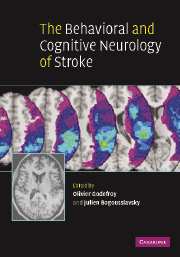Book contents
- Frontmatter
- Contents
- Contributors
- Preface
- 1 Evaluation of cognitive and behavioral disorders in the stroke unit
- Motor and gestural disorders
- Aphasia and arthric disorders
- Hemineglect, Anton–Babinski and right hemisphere syndromes
- 9 Hemispatial neglect
- 10 Anosognosia and denial after right hemisphere stroke
- 11 Asomatognosia
- 12 Disorders of visuoconstructive ability
- 13 Topographical disorientation
- Agnosia and Bálint's syndrome
- Executive and memory disorders
- Behavioral and mood disorders
- Dementia and anatomical left/right syndromes
- Index
- References
12 - Disorders of visuoconstructive ability
Published online by Cambridge University Press: 10 October 2009
- Frontmatter
- Contents
- Contributors
- Preface
- 1 Evaluation of cognitive and behavioral disorders in the stroke unit
- Motor and gestural disorders
- Aphasia and arthric disorders
- Hemineglect, Anton–Babinski and right hemisphere syndromes
- 9 Hemispatial neglect
- 10 Anosognosia and denial after right hemisphere stroke
- 11 Asomatognosia
- 12 Disorders of visuoconstructive ability
- 13 Topographical disorientation
- Agnosia and Bálint's syndrome
- Executive and memory disorders
- Behavioral and mood disorders
- Dementia and anatomical left/right syndromes
- Index
- References
Summary
General presentation of visuoconstructive disorders
This chapter deals with the inability to assemble the elements of a two- or three-dimensional object, respecting their orientations and spatial relationships. This disorder is generally known as “constructional apraxia,” a term introduced by Kleist (1934) and frequently used in clinical practice. According to Benton's definition (1967), “constructional apraxia denotes an impairment in combinatory or organizing activity, in which details must be clearly perceived and in which the relationships among the component parts of the entity must be apprehended if the desired synthesis of them is to be achieved.” Since the term apraxia introduces some confusion with other varieties of apraxia, the term “disorders of visuoconstructive ability” is frequently preferred and will be used here.
Impairment of visuoconstructive ability is easily demonstrated in a patient with abnormalities in drawings (either free or copied) not explained by low visual acuity or motor disorders. Drawing difficulties related to purely motor, cerebellar, proprioceptive or extrapyramidal disorders are not considered to be apraxic. In addition, gestural apraxia per se does not induce visuoconstructive impairment (Ajuriaguerra et al., 1960). Drawing disturbances related to visual agnosia, simultagnosia and Bálint's syndrome are usually considered to be secondary to perceptual disorders and are not classified as apraxic. From a practical point of view, the examiner must ensure that the patient's ability to identify the figure to be copied is spared before concluding a disorder of visuoconstructive ability. Finally, visuoconstructive disorders are frequently associated with hemineglect, especially in right brain damage.
- Type
- Chapter
- Information
- The Behavioral and Cognitive Neurology of Stroke , pp. 254 - 268Publisher: Cambridge University PressPrint publication year: 2007
References
- 2
- Cited by



